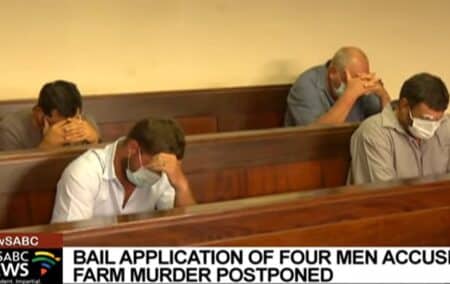The death of the Coka brothers, Amos and Zenzele, on 9 April, caused national controversy.
According to the official narrative, as told by the South African Police Service (SAPS), the mayor of Piet Retief (Mkhondo) and Mpumalanga premier Refilwe Mtshweni-Tsipane, the two men were murdered and another was assaulted grievously by at least four farmers while seeking work.
Another version of the events of that fateful day has subsequently unfolded, according to which the Coka brothers were part of a group that invaded a farm, assaulted farm workers, a farm manager and farm owners.
On this version, during the course of the assault, one Coka brother struck a blow to Hansie Moolman’s head, knocking him out, then stole Moolman’s gun and started shooting wildly, accidently shooting the other Coka brother before being killed himself by a shot allegedly fired by Othard Klingenberg in self-defence.
Going on the first version, four suspects – Daniel Malan, Cornelius Greyling, Othard Klingenberg, and Ignatius Steynberg – were arrested on 9 April.
The Daily Friend has confirmed with SAPS that a fifth suspect, Zenzele Yende, was arrested six days later, on Thursday night.
Yende is a farm manager at Pampoenkraal, the farm on which the Coka brothers died and from which Moolman was rushed to hospital.
To establish which version is true will require seeking out and corroborating hard evidence, but one eyewitness on the scene has told the Daily Friend that SAPS may have botched key evidence. According to this witness, who prefers to remain anonymous pending any potential testimony before the court, SAPS made two key errors.
First, while SAPS did swab the hands of the accused, on the scene, for traces of gunpowder for testing in a forensic laboratory later, SAPS did not swab the hands of the deceased Coka brother who, on the second version, stole a firearm and used it to shoot wildly, threatening the lives of all around him and killing his brother.
SAPS is reported to have said, when questioned as to whether they would swab the deceased for gunpowder, that at that point they had run out of swabs and were therefore unable to conduct the test at that time.
The Daily Friend has communicated with SAPS and the National Prosecuting Authority to ask whether a gunpowder residue test was at any point conducted on the deceased and, if so, whether this was done credibly and transparently. No answer was given, citing the sub judice rule.
The relevance of this evidence could hardly be overstated. If gunpowder residue is found on one of the hands of the deceased, it would devastate the first version, according to which the Coka brothers (and the rest of the group) were both unarmed, innocent work-seekers acting benignly until they were viciously assaulted, and then murdered by the accused, currently sitting in jail despite concrete exculpatory evidence.
If, by contrast, a transparent and credible test had been done demonstrating zero gunpowder residue on either of the Coka bothers’ hands, this would explode the accused’s version, as far as it can be ascertained, according to which they acted in self-defence.
That such evidence may not appear one way or another credibly before court because of a lack of swabs would be a shocking indictment of the investigative process.
According to the eyewitness, there is a second major problem.
When SAPS arrived on the scene, they followed the procedure of locating all discharged gun cartridges on the ground, and collecting them for ballistic investigation, but not before placing cones on their exact location for a positional record.
Before the official photographer arrived to capture a permanent picture, however, the cones were removed. When the photographer asked where the demarcating cones were, a SAPS officer reportedly grabbed a bunch of cones and replaced them on the scene. But whether they were replaced in their accurate locations is impossible to tell.
This seriously undermines the credibility of the official police photographs, raising the question of whether it will be possible for either prosecution or defence to draw on cartridge locations in the official photographs to paint a picture of how the scene must have played out according to the physical evidence.
Again, the alleged failure to capture and record evidence credibly could be devastating to the pursuit of justice in the case. The Daily Friend is actively investigating whether other witnesses on the scene corroborate or contradict the questions raised about police conduct and potentially botched forensic evidence.
This is an on-going story.

